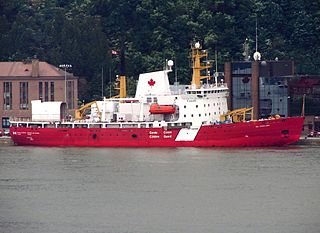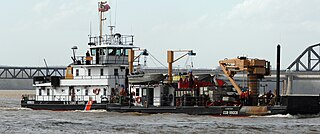
An icebreaker is a special-purpose ship or boat designed to move and navigate through ice-covered waters, and provide safe waterways for other boats and ships. Although the term usually refers to ice-breaking ships, it may also refer to smaller vessels, such as the icebreaking boats that were once used on the canals of the United Kingdom.

The Canadian Coast Guard is the coast guard of Canada. Formed in 1962, the coast guard is tasked with marine search and rescue (SAR), communication, navigation, and transportation issues in Canadian waters, such as navigation aids and icebreaking, marine pollution response, and support for other Canadian government initiatives. The Coast Guard operates 119 vessels of varying sizes and 23 helicopters, along with a variety of smaller craft. The CCG is headquartered in Ottawa, Ontario, and is a special operating agency within Fisheries and Oceans Canada.

CCGS Terry Fox is a Canadian Coast Guard heavy icebreaker. She was originally built by Burrard-Yarrows Corporation in Canada in 1983 as part of an Arctic drilling system developed by BeauDril, the drilling subsidiary of Gulf Canada Resources. After the offshore oil exploration in the Beaufort Sea ended in the early 1990s, she was first leased and then sold to the Canadian Coast Guard.

CCGS Louis S. St-Laurent is a Canadian Coast Guard (CCG) heavy icebreaker. Louis S. St-Laurent's home port is St. John's, Newfoundland and Labrador. It is the largest icebreaker and flagship of the CCG.

CCGS Des Groseilliers is a Pierre Radisson-class icebreaker in the Canadian Coast Guard. The vessel is named after Médard Chouart des Groseilliers (1618–1669) a close associate of Pierre-Esprit Radisson in explorations west of the Great Lakes and the founding of the British Hudson's Bay Company. The ship entered service in 1982. The vessel has participated in a number of research voyages, including Ice Station SHEBA. As part of the Surface Heat Budget of the Arctic Ocean experiment conducted in the Arctic Ocean from October 1997 to October 1998 to provide polar input to global climate models, Des Groseilliers was allowed to be frozen into the ice for the Arctic winter, to serve as a base for scientific researchers.

The Wind-class icebreakers were a line of diesel electric-powered icebreakers in service with the United States Navy, United States Coast Guard, Royal Canadian Navy, Canadian Coast Guard and Soviet Navy from 1944 through the late 1970s. They were very effective ships: all except Eastwind served at least thirty years, and Northwind served in the USCG continuously for forty-four years. Considered the most technologically advanced icebreakers in the world when first built, the Wind-class icebreakers were also heavily armed; the first operator of the class was the United States Coast Guard, which used the vessels for much-needed coastal patrol off Greenland during World War II. Three of the vessels of the class, Westwind, Southwind, and the first Northwind all went on to serve temporarily for the Soviet Union under the Lend-Lease program, while two others were built for the United States Navy and another was built for the Royal Canadian Navy; all eight vessels were eventually transferred to the United States Coast Guard and the Canadian Coast Guard.

A buoy tender is a type of vessel used to maintain and replace navigational buoys. This term can also apply to an actual person who does this work.

USCGC Westwind (WAGB-281) was a Wind-class icebreaker that served in the United States Coast Guard as USCGC Westwind (WAG-281), the Soviet Navy as the Severni Polius, and again in the U.S. Coast Guard as USCGC Westwind (WAGB-281).

CCGS John A. Macdonald was a Canadian Coast Guard heavy icebreaker. She was named after The Right Honourable, Sir John Alexander Macdonald, the first Prime Minister of Canada. The ship was commissioned into the Canadian Department of Transport's Marine Service in 1960 using the prefix "Canadian Government Ship" (CGS). The vessel was transferred in 1962 into the newly created Canadian Coast Guard (CCG) and served with distinction until being decommissioned in 1991, and replaced by the then-chartered CCGS Terry Fox.

The Polar 8 Project was a Canadian shipbuilding project intended to provide the Canadian Coast Guard with a large and heavy class icebreaker capable of operating year-round in the Northwest Passage. The project was developed as a means to assert Canada's sovereignty in the Arctic Ocean. It commenced in 1985 but was cancelled in 1990 while still in the final design stage. It was Canada's direct response to the unauthorized transit through the Northwest Passage in summer 1985 by USCGC Polar Sea, a United States Coast Guard icebreaker. Polar 8 refers the capability of the ship in ice of that thickness in feet, in this case 8 feet (2.4 m). Initiated in 1985, the vessel was never constructed and the project was cancelled in 1988.

CCGS John G. Diefenbaker is the name for a Canadian Coast Guard icebreaker that had been expected to join the fleet by 2017 but has been significantly delayed. Her namesake, John G. Diefenbaker, was Canada's 13th prime minister. It was Diefenbaker's government that founded the Canadian Coast Guard in 1962.

Polar Class (PC) refers to the ice class assigned to a ship by a classification society based on the Unified Requirements for Polar Class Ships developed by the International Association of Classification Societies (IACS). Seven Polar Classes are defined in the rules, ranging from PC 1 for year-round operation in all polar waters to PC 7 for summer and autumn operation in thin first-year ice.

CCGS Captain Molly Kool is a Canadian Coast Guard converted medium class icebreaker. She was originally built as an icebreaking anchor handling tug Vidar Viking for Trans Viking Icebreaking & Offshore in 2001. The vessel was acquired by the Canadian Coast Guard in August 2018 and was commissioned in May of the next year after refit.

CCGS Jean Goodwill is an icebreaking anchor handling tug supply vessel (AHTS) converted to a medium class icebreaker for the Canadian Coast Guard. She was originally built as Balder Viking for Trans Viking Icebreaking & Offshore AS in 2000. The vessel was sold to Canada in 2018 and was initially expected to enter service in late 2019 following a refit. However, due to delays the conversion of the vessel was not completed until November 2020.

CCGS Vincent Massey is an icebreaking anchor handling tug supply vessel (AHTS) converted to a medium class icebreaker for the Canadian Coast Guard. She was originally built as Tor Viking for Trans Viking Icebreaking & Offshore AS in 2000 and has also traded under the name Tor Viking II. The vessel was sold to Canada in 2018 and was initially expected to enter service in summer 2020 following a refit. However, the conversion work was delayed and the vessel was delivered to the Canadian Coast Guard in October 2022.
The National Shipbuilding Strategy (NSS), formerly the National Shipbuilding Procurement Strategy (NSPS), is a Government of Canada program operated by the Department of Public Works and Government Services. The NSS was developed under the Stephen Harper Government in an effort to renew the fleets of the Royal Canadian Navy (RCN) and the Canadian Coast Guard (CCG). The strategy was broken into three sections; the combat package, the non-combat package and the smaller vessel package. The companies who won the bids for the larger ships were not permitted to bid on the smaller vessel package. In 2019 the Trudeau Government decided to add a third shipyard to the NSS specializing in the construction of icebreakers for the Coast Guard. The agreement to incorporate Davie as a third shipyard within the NSS was finally signed in April 2023.

The Polar Security Cutter Program is a program to recapitalize the United States Coast Guard's aging fleet of icebreakers, currently consisting of the heavy icebreaker USCGC Polar Star and the medium icebreaker USCGC Healy, with three new multi-mission vessels referred to as Polar Security Cutters (PSC). These heavy polar icebreakers will allow the USCG to perform its statutory missions in the Arctic as well as support the United States Antarctic Program with Operation Deep Freeze.
CCGS Judy LaMarsh is a Canadian Coast Guard light icebreaker. Built in 2010 as a shallow-draught icebreaking tug Mangystau-2 for the Caspian Sea oil fields, the vessel was acquired by Canada as an interim solution while the existing fleet undergoes service life extension and maintenance.















